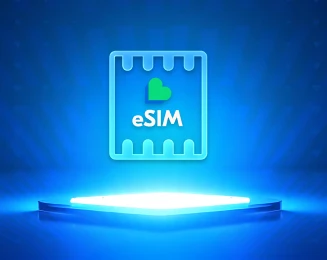

What is an eSIM?
eSIM stands for “embedded SIM”. It is a small chip built into devices - including iPhones - that replaces the traditional removable plastic SIM card. This chip is programmable remotely by your mobile network operator. Instead of inserting a physical SIM, you download the carrier profile via QR code or activation link. The process is secure, efficient, and designed for modern connectivity needs. The advantages of eSIM include:
- Convenience: No physical card insertion or replacement is needed, reducing the risk of damage or loss.
- Flexibility: Multiple network profiles can coexist. You can switch carriers or plans on the iPhone at any time without changing cards.
- Sustainability: Fewer plastic SIM cards manufactured means reduced waste and lower environmental impact.
- Future-proof: As more devices adopt eSIM, the infrastructure and carrier support improve, making eSIM the standard in mobile connectivity.
For travel or business use, eSIM enables swift activation of local plans abroad, eliminating roaming hassle and allowing users to select the best network in real time.
What is eSIM on iPhone?
On the iPhone, an eSIM is an embedded SIM technology that allows you to use a mobile network without inserting a physical SIM card. It is built into the device and supports remote provisioning of mobile plans. This means you can download a plan directly to the iPhone, switch providers or subscriptions with no need for a new plastic SIM, and manage multiple lines more flexibly. The technology is fully integrated with the iPhone’s cellular settings, enabling streamlined activation, dual-SIM usage (physical + eSIM), and convenient toggling between multiple profiles when needed.
Set up eSIM on iPhone
To set up an eSIM on your iPhone, ensure your device is unlocked and compatible with eSIM functionality. On the iPhone, go to Settings → Cellular (or Mobile Data) → Add Cellular Plan. Scan the QR code or enter the activation details provided by your carrier. Once the profile downloads, assign the line as primary or secondary and configure voice/data preferences. Confirm that the plan becomes active and test it by making a call or using mobile data. If any issues arise, contact the carrier’s support for confirmation of activation and network connection.
Connect faster with eSIM
With eSIM you connect faster. On the iPhone, activation takes only a few taps: no need for a store visit or waiting for delivery. Because the profile is downloaded instantly, you can go from purchase to data/calling service immediately. eSIM supports rapid switching: you can store multiple carrier profiles on the iPhone and shift between them based on coverage, cost, or purpose. For frequent travelers, the benefit is immediate international network access without swapping cards. The speed of provisioning, flexibility of switching, and reduction of physical dependencies translate into a smoother mobile connectivity experience.
Before you begin
Before activating an eSIM on your iPhone, verify these prerequisites:
- Ensure your iPhone model supports eSIM and is unlocked.
- Choose a carrier or mobile plan that offers eSIM activation.
- Obtain the carrier-provided QR code or activation link/profile details.
- Have a stable Wi-Fi connection (or mobile data) to download the eSIM profile.
- Confirm that you understand how the line will be used (data, voice, primary vs secondary) and configure accordingly.
- Back up your iPhone in case you need to restore network settings or re-activate the profile later.
- Read any critical information about terms, coverage, and how switching lines affect your service.
Once these conditions are met, proceed with the setup outlined under Set up eSIM on iPhone. Following these steps ensures you maximize the benefits of eSIM, including quicker activation, flexibility in plan/line choice, and alignment with modern mobile connectivity expectations.
In Australia the transition toward eSIM is accelerating. The embedded SIM model aligns with both environmental goals (reduction of plastic waste) and consumer demands (multiple network access, smoother registration, travel-friendly switching). Australians benefit from being able to use the iPhone with eSIM to access networks more dynamically — switching carriers or choosing best-coverage providers without physical constraints. eSIM on iPhone offers notable advancements: one device, multiple profiles, rapid activation, and reduced dependence on physical SIM logistics. As telecom providers continue to expand eSIM availability and compatible devices become more common, the eSIM-enabled iPhone marks a pivotal shift in how mobile connectivity is managed and experienced.
